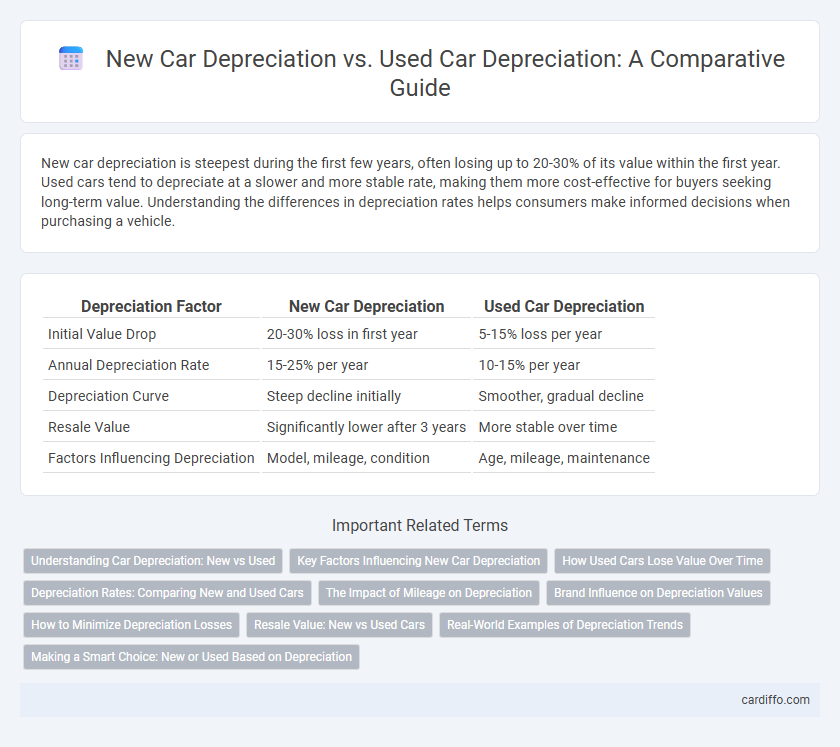New car depreciation is steepest during the first few years, often losing up to 20-30% of its value within the first year. Used cars tend to depreciate at a slower and more stable rate, making them more cost-effective for buyers seeking long-term value. Understanding the differences in depreciation rates helps consumers make informed decisions when purchasing a vehicle.
Table of Comparison
| Depreciation Factor | New Car Depreciation | Used Car Depreciation |
|---|---|---|
| Initial Value Drop | 20-30% loss in first year | 5-15% loss per year |
| Annual Depreciation Rate | 15-25% per year | 10-15% per year |
| Depreciation Curve | Steep decline initially | Smoother, gradual decline |
| Resale Value | Significantly lower after 3 years | More stable over time |
| Factors Influencing Depreciation | Model, mileage, condition | Age, mileage, maintenance |
Understanding Car Depreciation: New vs Used
New car depreciation occurs rapidly, with values typically dropping 20-30% within the first year due to initial market saturation and loss of novelty. Used car depreciation generally slows down, averaging a 10-15% decline annually as the vehicle's value stabilizes after the steep initial drop. Understanding these depreciation patterns helps buyers and sellers make informed decisions about timing purchases and sales to maximize financial benefits.
Key Factors Influencing New Car Depreciation
New car depreciation is significantly influenced by initial purchase price, rapid value loss during the first few years, and manufacturer warranties that affect resale appeal. Factors such as vehicle make, model popularity, mileage, and market demand crucially determine the rate at which a new car depreciates compared to used cars. Understanding these elements helps buyers predict long-term costs and make informed decisions on new car investments.
How Used Cars Lose Value Over Time
Used cars lose value over time primarily due to mileage accumulation, wear and tear, and market demand shifts, leading to a steadier but slower depreciation rate compared to new cars. Unlike new cars, which experience the steepest value loss within the first few years, used vehicles depreciate more gradually, with factors like maintenance history and vehicle condition significantly influencing their resale value. The average annual depreciation rate for used cars typically ranges between 10% and 15%, slowing as the vehicle ages beyond five years.
Depreciation Rates: Comparing New and Used Cars
New cars typically experience a depreciation rate of 20-30% within the first year, significantly higher than used cars which depreciate at a steadier rate of around 10-15% annually. The rapid initial depreciation of new vehicles is due to the immediate loss of "new car" status and market demand fluctuations. Used cars tend to retain value longer because their initial steep depreciation has already occurred, making their depreciation rates more predictable and gradual.
The Impact of Mileage on Depreciation
New car depreciation accelerates significantly with higher mileage, often losing 15-25% of its value within the first year as mileage increases beyond 12,000-15,000 miles annually. Used cars experience a slower depreciation rate, but mileage still plays a critical role, with vehicles exceeding 100,000 miles facing sharper value declines compared to those with lower mileage. High mileage reduces resale value by signaling increased wear and potential maintenance costs, impacting both new and used car market prices.
Brand Influence on Depreciation Values
Brand reputation significantly impacts both new and used car depreciation rates, with luxury brands typically retaining value better due to perceived quality and desirability. New cars from premium manufacturers often experience slower depreciation compared to economy brands, maintaining higher resale values within the first five years. In the used car market, strong brand loyalty and reliability ratings further reduce depreciation, preserving value and demand over time.
How to Minimize Depreciation Losses
New cars typically lose 20-30% of their value within the first year, making initial depreciation the steepest. Purchasing a slightly used vehicle, ideally 2-3 years old, can significantly reduce depreciation losses since the initial drop has already occurred. Regular maintenance, avoiding excessive mileage, and choosing popular models help preserve car value and minimize depreciation over time.
Resale Value: New vs Used Cars
New cars typically lose 20-30% of their value within the first year, significantly impacting resale value compared to used cars, which depreciate at a slower, more predictable rate. Used cars often retain a higher percentage of their purchase price over time because the steep initial depreciation has already occurred. Understanding the difference in depreciation rates is crucial for maximizing resale value and making cost-effective vehicle investment decisions.
Real-World Examples of Depreciation Trends
New car depreciation averages 20-30% in the first year, with vehicles like the 2023 Toyota Camry losing approximately $6,000 in value within 12 months. Used cars, such as a 2018 Honda Civic, typically experience slower depreciation rates, around 10-15% annually, reflecting more stabilized market values. Real-world data from Kelley Blue Book shows that depreciation for luxury models like the BMW 5 Series can approach 40% after three years, significantly impacting resale prices compared to economy cars.
Making a Smart Choice: New or Used Based on Depreciation
New car depreciation typically occurs fastest within the first three years, with values dropping by up to 60%, while used cars tend to depreciate more slowly, often losing only 15-20% per year. Choosing a used car can maximize value retention and minimize initial depreciation loss, making it a smart financial decision for budget-conscious buyers. Analyzing depreciation curves and considering long-term ownership costs helps optimize the balance between purchase price and resale value.
New Car Depreciation vs Used Car Depreciation Infographic

 cardiffo.com
cardiffo.com